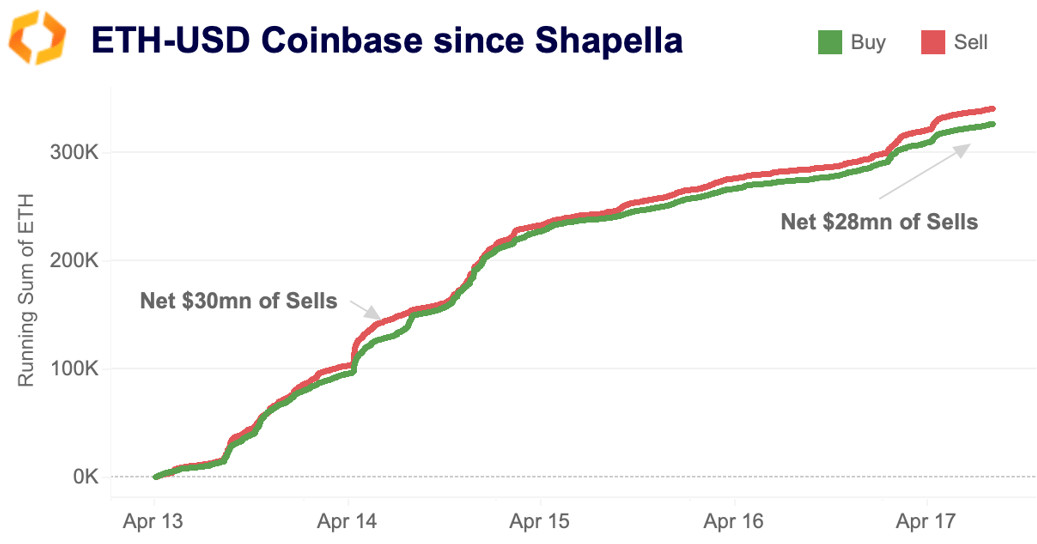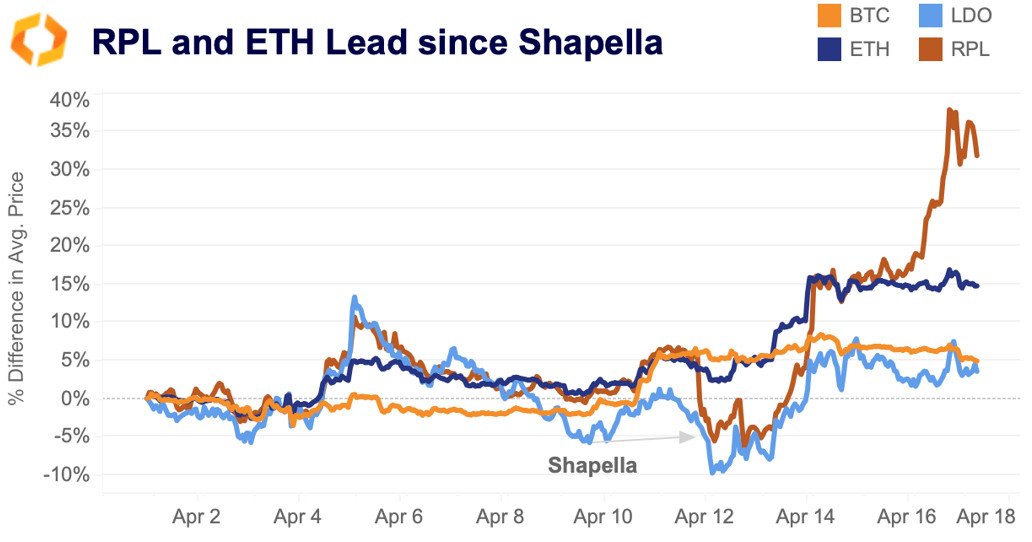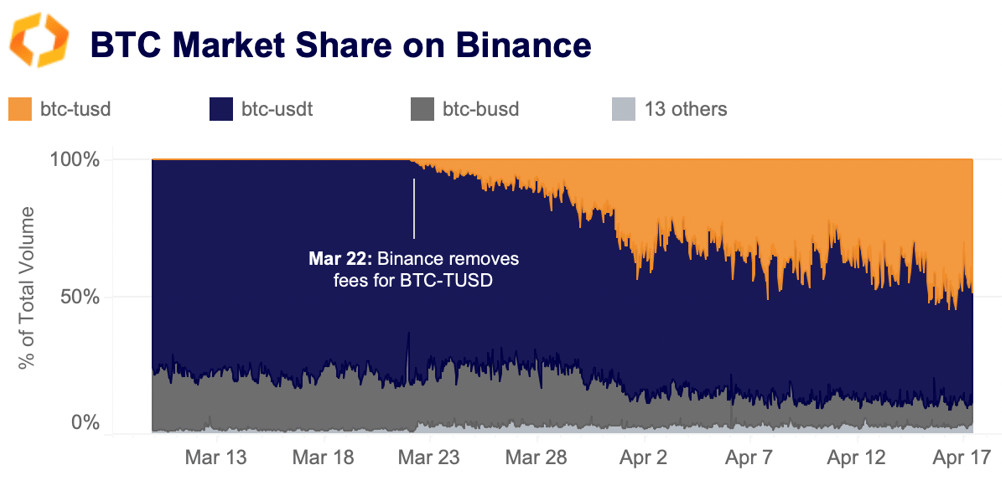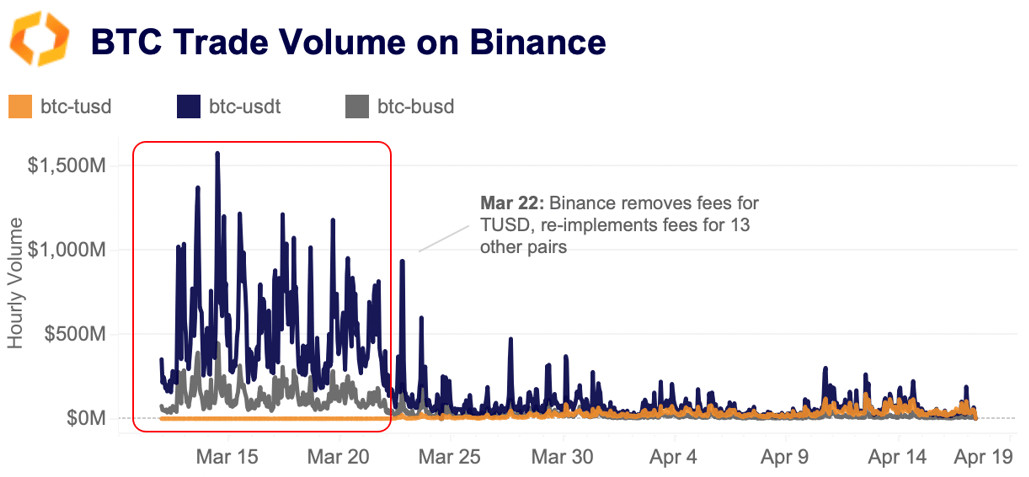A summarizing review of what has been happening at the crypto markets of the past week. A look at trending sectors, liquidity, volatility, spreads and more. The weekly report in cooperation with market data provider Kaiko.
ETH hit 11-month highs following the Shapella upgrade despite expectations of significant sell pressure after more than 1mn staked ETH were withdrawn. BTC also soared past $30k for the first time since last June and is up more than 80% YTD. Today we explore:
- ETH's post-upgrade rally and bullish derivatives trends
- The rise of TUSD on Binance
- The shift in trade volume towards APAC hours
ETH soars following Shapella upgrade

Last week, the Shapella upgrade went live without a hitch, enabling millions of staked ETH to be withdrawn. While Ethereum's Merge upgrade last September was more of a "buy the rumor sell the news" type of event, Shapella appears to have had the opposite impact on price. ETH spot prices dropped by nearly 18% post-Merge while they are up 11% since Shapella, despite fears of mass selling.
Interestingly, despite ETH’s rally, the Coinbase ETH-USD pair has seen more sell orders than buys. Coinbase is ahead of its rival Binance in granting withdrawals of ETH staked with the centralised exchange and early analysis of buy/sell volume suggests this has led traders to cash out their ETH for USD.
As it became possible to redeem staked ETH for ETH on Coinbase, tick trade data shows sells of ETH outpaced buys by over $30mn. That number stands at $28mn of net sells as of this morning, but is nevertheless an interesting dynamic to watch, particularly ahead of Binance enabling withdrawals on April 19, which could result in more sell pressure for ETH.
There were significant inflows in derivatives markets last week, suggesting that the overall market sentiment is turning bullish. ETH option volumes on the largest options market Deribit exceeded $1bn for the first time since the FTX collapse, driven by bullish bets.
Rocketpool outperforms ahead of Atlas update
Since the Shapella update, Rocketpool (RPL) has dramatically outperformed not only BTC and ETH, but also its closest rival and market leader of liquid staking protocols, Lido (LDO). Rocketpool is a smaller player in the Ethereum staking industry at the moment, with only 2% market share of depositors, compared to Lido’s 31% and Coinbase’s 12%.
However, since Shapella, RPL is up close to 40% amidst potentially bullish catalysts. Rocketpool is also undertaking its own update this week, Atlas, which will decrease the amount of ETH required to become a validator on the protocol from 16 ETH to 8 ETH. Usually 32 ETH is required to become a validator on the Ethereum network, so this upgrade should give Rocketpool a competitive edge over other protocols in the form of more validators and a more decentralized network and may allow it to gain market share.
ETH's correlation with BTC dips to 3-month low
BTC's correlation with ETH, calculated using a 30-day rolling window, has dropped to its lowest level since January, following BTC's double digit March rally. While ETH gained some traction last week, it has been underperforming in March as investors took a cautious approach amid rising regulatory scrutiny. The correlation between the two assets has been particularly volatile over the past seven months, after it hovered around 90% for most of the past year. The trend could suggest that investors are increasingly perceiving BTC and ETH as conceptually different assets instead of grouping them together. The two successful major ETH upgrades within just 8 months will probably contribute to this shift.
TUSD claims 50% market share on Binance
That was fast. It took less than one month for Binance's BTC-TUSD pair to become the largest bitcoin market on the exchange (and in the world). On March 22, Binance halted its zero-fee trading program for 13 BTC trading pairs. The exchange also re-listed its BTC-TUSD market and removed trading fees for the pair, making it the only fee-less pair on the exchange. Last week, trade volumes for the pair officially surpassed 50% relative to all other BTC pairs for the first time, including BTC-USDT.
When looking at trade volume for the top three BTC pairs on Binance, we can see a dramatic drop ever since Binance changed its fee policy. TUSD has grown from nothing to around $60mn an hour, but this is paltry compared with USDT's average of nearly $1bn an hour before fees were re-implemented.
While TUSD is now dominant on Binance, the data suggests that most traders are still reluctant to begin trading the relatively unknown stablecoin. Ultimately, Binance's market share is still down 10% since the change in fees, and it looks like one zero-fee pair for a small stablecoin is not enough to reclaim what was lost (for now).
Curve processes 85k stETH volume in three days
Curve facilitated the vast majority of stETH volume across any exchange, centralized or decentralized, as nearly 85k stETH (over $150mn USD) was traded from April 11-13, with April 12 the day of the upgrade. During this time period, Uniswap V2 and V3 processed just under 500 stETH volume combined. Additionally, on Curve, these days were nearly perfectly balanced in buy and sell volume; sells had outpaced buys for the entire week before the upgrade. Over the weekend, buys became dominant, accounting for 11.5k ETH of the pair’s 15k ETH volume.
U.S. volume decreases on Binance following lawsuit
Last week, we showed that trading volume for BTC perpetual futures on Binance have increasingly shifted toward U.S. trading hours over the past year. However, in the three weeks since the CFTC filed a lawsuit alleging that the exchange was allowing U.S. customers to trade derivatives on its international platform, we have seen a reversal of that trend.
Since March 27, the share of trading between 1:00pm and 8:00pm UTC (9:00am-4:00pm ET) has fallen from 49.1% to 43.5%. By contrast, the share of trading during APAC opening hours (1pm-7 p.m. UTC) has increased from 17.6% to 24%. Despite a slight increase in trading during the overlap between EU and APAC hours, the overall share of trading during EU opening hours has declined. This shift, which occurred relatively quickly after the initiation of the lawsuit, could indicate both a drop in U.S. activity and migration towards APAC.
Bitcoin's correlation with U.S. equities diverges
The gap between BTC's correlation with the tech-heavy Nasdaq 100 and the broader S&P 500 is the widest since May 2021. BTC, up 52% since March 10, remains more correlated with tech stocks, which have also benefited from bets on Fed easing and are up 11%. The S&P 500 lagged behind, dragged down by falling financials, which make up about 10% of the index. Its correlation with BTC is currently at a two-year low of just 15%. Overall, BTC moved less in line with risk assets this year as crypto-specific factors such as low liquidity and seller exhaustion also played a role in price performance.
















